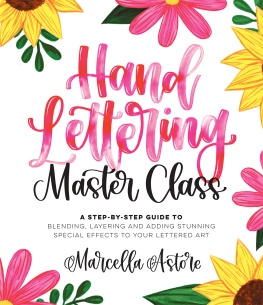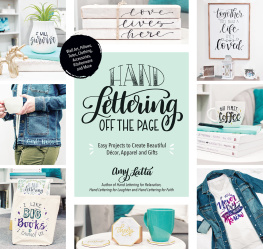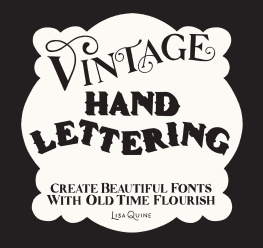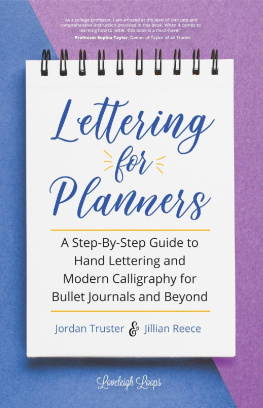Contents
Guide
Hand Lettering
Master Class
A STEP-BY-STEP GUIDE TO
BLENDING, LAYERING AND ADDING STUNNING SPECIAL EFFECTS TO YOUR LETTERED ART
Marcella Astore
The author and publisher have provided this e-book to you for your personal use only. You may not make this e-book publicly available in any way. Copyright infringement is against the law. If you believe the copy of this e-book you are reading infringes on the authors copyright, please notify the publisher at: http://us.macmillanusa.com/piracy.
THIS BOOK IS DEDICATED TO MY FAMILY, ESPECIALLY MY PARENTS, WHO HAVE ALWAYS SUPPORTED ME IN ALL OF MY ENDEAVORS.
Hi! My name is Marcella and I am so excited that youre interested in learning some of my favorite lettering techniques. This book is full of my tips and tricks for adding beautiful scenes and patterns inside of your lettering. These in-depth, step-by-step tutorials show my full process for creating some of my favorite lettering projects, along with my guidance on how you can easily replicate them yourself.
Im a lettering artist who specializes in creating vibrant lettered art. When I first started lettering, I stuck to the usual beginner projects, like lettering with one marker at a time, doing some simple blending and playing around with different styles until I found my own. Since then, Ive become known in the lettering community for pushing the limits on what can be added into lettering, from landscapes to patterns to turning the letters into something else entirely.
I took the definition of lettering (the art of drawing letters), rather than calligraphy (the art of writing), to heart while creating these projects. Not only will you learn how to draw the letters themselves in various styles, but youll also learn how to draw a myriad of designs inside of your lettering. It helps if you have some basic knowledge of lettering, but thats not required. Ill go over some of my favorite lettering styles and basic techniques before diving into the full tutorials.
These projects are detailed and will require time and patience, but once you see your finished work, itll be worth it.

Although practice is the most important step in creating beautiful lettering pieces, supplies can also play a big role in how your projects turn out. Since lettering has become a pretty popular hobby, there are a bunch of options available. Ive tried out a lot of different choices and have figured out which ones work best, especially for the types of projects youll find in this book.
From markers to paper to paintbrushes, there have been so many times that I attempted to use something that either wasnt made for what I was trying to do or just didnt work well. Regardless of whether youre an absolute beginner or a lettering pro, using the wrong supplies can hinder your artwork and discourage you from continuing to letter, but using the right supplies can enhance your artwork. Ive compiled all of my favorite tried-and-true lettering supplies below!
BRUSH PENS
First up are the most-used items for these projectsbrush pens. One of the most important factors in choosing which brush pens to use, especially in the following projects, is whether or not they have water-based ink. Luckily, the majority of the most popular large brush pens, including all of the ones Ive listed, are water-based!
While not every project requires water-based ink, many do since youll be doing lots of blending with water. If you try to add water to a marker that doesnt have water-based inkfor example, an oil-based paint marker or an alcohol-based markerthe water will not allow the ink to lift and move around. If you cant move the ink around from the marker you used, you wont be able to use the blending methods I use for the projects in this book. You can easily use a water-based brush pen for the projects that dont require blending, but that doesnt work the other way around.
In terms of sizes, I used large brush pens for all of the upcoming projects, but Ive included some of my favorite small brush pens as well!
LARGE BRUSH PENS: These are what youll want to use to create large lettering that really pops! All of these are sold both in sets and as individual markers, so you have lots of options to choose from.
TOMBOW DUAL BRUSH PENS: These are my absolute favorite brush pens and what I used for all of the projects in this book. They have the firmest tip out of these three options and dont release so much ink that the lettering looks wet before it dries, which is what I prefer, especially when Im planning on blending the ink with water. Although no single 10-pack set will have all the colors needed to complete every project in this book, I really love the Bright, Primary and Pastel 10-packs because they give you a wide variety of colors that encompass most of the colors used in the upcoming projects. If you do grab a pack, keep in mind that you may also need gray brush pens in order to use my method of sketching and adding shadows. More on that soon!
ECOLINE BRUSH PENS: These have softer tips than the Tombow Dual Brush Pens and release slightly more ink when you letter with them. They naturally create a nice gradient effect as you add and release pressure while lettering, which can be a nice touch, especially in cases when you dont blend the ink with water afterwards.
KARIN BRUSHMARKER PRO: The defining factor of these is that they release a lot of ink when you use them. This makes the colors vibrant but can also lead to longer drying times. Since so much ink comes out at once, you can sometimes get a watercolor bleed effect by using just the markers, which would otherwise only happen when you also use a paintbrush and water.
SMALL BRUSH PENS: These could be used for some of the smaller, less important words in lettering designs, especially articles and filler words.
TOMBOW FUDENOSUKE BRUSH PENS: These have a hard tip, which means that the contrast in size between the upstrokes and downstrokes wont be too large. They are especially great for beginners since the firmer tip is easy to control. I mainly use these in black, but they also come in a bunch of colors.
PENTEL SIGN BRUSH PENS: These have a softer tip and write very smoothly. A huge plus with these is that they have a very wide color range, which makes them easy to incorporate into whatever color scheme you are using.
TIP: While brush pens are always recommended for lettering, some normal markers can also be pressure sensitive. If you decide to try lettering with something other than brush pens, youll want to avoid bullet or chisel tip markers. Markers that have a relatively flexible tip and come to a point are your best bet. My favorite regular markers that can double as brush pens are Crayola Broad Tip Markers and Crayola Super Tips.
COLOR SWATCHES
Picking accurate colors can be difficult, so Ive compiled a list of all the large brush pen colors needed to complete the projects in this book, along with the exact names and/or numbers of each shade. I used Tombow Dual Brush Pens throughout the book, but Ive also included similar shades in other recommended brands as well.










